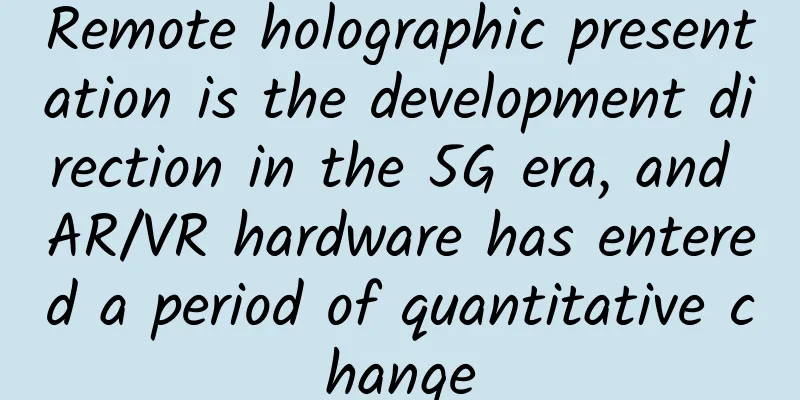Remote holographic presentation is the development direction in the 5G era, and AR/VR hardware has entered a period of quantitative change

|
"Holographic telepresence is expected to become a killer use case for spatial computing. It has shown strong momentum recently and has achieved significant improvements. Just like games, applications that can provide social functions will become the most popular application types." This was the explanation of the future of holographic telepresence by Qualcomm representative Si Hongguo at the HTC VIVE Virtual Ecosystem Conference a few days ago. Obviously, Qualcomm believes that the 5G era is a new communication direction. In the 5G era, the integration of 5G, AI and spatial computing will realize holographic telepresence. At present, many applications with social attributes have achieved success. For example, "RecRoom" has a market value of up to 1 billion US dollars. The VIVE XR Suite launched by HTC last year successfully promoted cooperation in the VR industry, etc. The future of mobile computing is shifting from mobile terminals to AR/VR/XR devices. Now is a good time for the developer community to start introducing excellent and practical immersive applications into AR/VR/XR devices. Just recently, China Unicom's 5G remote holographic interactive technology was unveiled at the Shandong Province Undergraduate College Informationization Observation Conference. At the conference, holographic technology achieved the presentation of 1:1 real-life stereoscopic images at the conference site. The large bandwidth and low latency characteristics of 5G technology ensure that the remote interaction process is as smooth as a live conversation. By combining virtual and real special effects, the demonstration effect is amazing. This 5G holographic remote interaction product provides an excellent case for remote holography. The combination of 5G with cloud, big data, AI, virtual simulation and other advanced technologies has further strengthened the new infrastructure of remote holographic education, and will create more application scenarios in the future. Gordon Moore, one of the founders of Intel, has a well-known theory: "The number of transistors that can be accommodated on an IC will double approximately every 18 months, and performance will also double." It is most often cited to describe the increasingly rapid pace of technological development and technological product upgrades. In fact, the same is true in the AR/VR industry. After entering the quantitative change period, both chip manufacturers and hardware and content manufacturers in the AR/VR industry will accelerate their progress on the road to the "breakthrough battle." Public data shows that VR headsets have ushered in a "quantitative change" era in the consumer market this year. Oculus Quest 2 sales exceeded 2.6 million in a single quarter, and several Quest store content revenues exceeded $1 million. Major technology media and UP hosts have begun to pay attention to VR again. Various data prove that VR devices may enter thousands of households in the near future.
In recent years, Facebook has bet on all-in-one VR devices, Zuckerberg called VR/AR the next generation computing platform, Apple and Google have been chasing each other in AR, more and more world-class companies have joined the VR/AR track, and major technology giants believe that the future of VR/AR is limitless. The current situation where many manufacturers are competing is a critical period for the transformation of contemporary mobile computing platforms to the next generation computing platforms. In the future, with the development of technology, AR/VR devices will further change from "quantitative change" to "qualitative change". By that time, AR/VR devices will truly enter thousands of households. |
>>: Programming Practice: How to parse domain names in the program
Recommend
Approaches to Solving Multiradio Hardware Design Challenges
The combination of multi-radio and multi-protocol...
The three major operators work together to embrace 5G positioning, accelerate capacity improvement, and jointly create an industrial ecosystem
Telecom operators are not only the builders and o...
About remote procedure call gRPC
If you have been exposed to distributed systems, ...
TripodCloud: San Jose CN2 GIA line starting at $38.99/half year, optional large hard drive
TripodCloud (Yunding Network) is a low-key Chines...
Little-known trick! How to draw a standard square in Excel
I turned on my computer and opened my beloved Exc...
Detailed explanation of several wireless transmission modes!
1. Access Point (AP) In this mode, the wireless n...
With HTTP protocol, why do we need Websocket?
[[428410]] WebSocket is a full-duplex communicati...
Behind Gu Ailing's victory at the Winter Olympics: Communications people are silently persevering
7×24 hours uninterrupted protection Communication...
Three-minute review! A quick overview of 5G industry development trends in May 2021
After the rapid development in 2020, 2021 is a cr...
5G messaging is about to be commercialized, and China Mobile plans to purchase technical support services
According to Zhongguancun Online, a "Notice ...
A 10,000-word article interprets the operators' fight for 5G: a battle of three kingdoms in financial strength
For a long time, the development of high-tech com...
AkkoCloud: San Jose/Germany/UK CN2 GIA, starting at 299 yuan per year, 300-600M bandwidth
AkkoCloud is a Chinese VPS hosting company founde...
Five ways to establish effective communication in remote teams
The term "remote" itself has a connotat...
Prefabricated Data Centers – Winning Edge Data Centers
Speed is critical for data. Data is being gener...
Communications man, what on earth have you done to Everest?
Do you still remember the 5G "cloud supervis...









